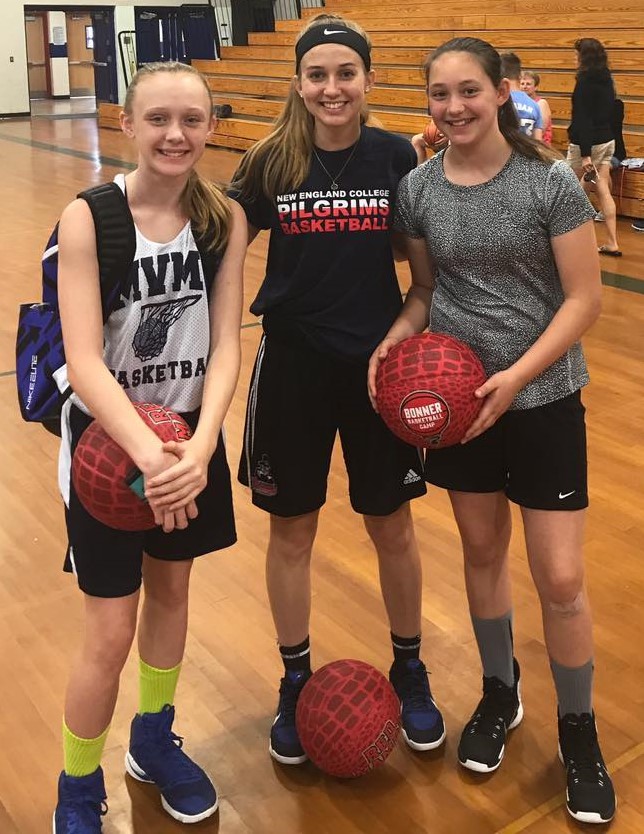Change is most often measured by time. It can be drastic and abrupt, or gradually begin to evolve. There is no exact algorithm or perfect science. It’s most likely not going to occur at the sound of snapping fingers or heel clicks of ruby red shoes.
The idea of women in sports has gained respect and acceptance as women’s place in society has improved. As an athlete who has aspirations to enter the male dominated world of sports, this improvement in equality is important to my present and future. Yet it is frustrating to experience disrespect at a young age, and have it continue as I grow, building up into a defense mechanism, and an assumption that is easily triggered; my opinion is not valued because of my gender.
It feels as though some people make comments on purpose, knowing they will stoke the rage inside of me. Others just seem to be blind with ignorance, unable to see another point of view.
When I was in the first grade, I remember being at an Applebee’s with my family in Concord, New Hampshire. I was sitting on the outside edge of the booth, at the time my brother and I always argued over who got to sit on the inside section. For a majority of my elementary school life, there was a New York Yankees cap on my head at all times. I took great pride in being a Yankees fan; being that my father was from the Bronx, I had watched them on TV my whole life. My meal was interrupted by a grown man yelling and disgustingly spitting in my six-year-old face, questioning if I knew whose territory I was in, and suggesting what I should do with my hat. My brother never again argued with me about who sits where in the booth.
I’ve carried that moment with me throughout my life. That same year my male classmates began to question if I was legitimately a Yankees fan. It wasn’t just the logo on my cap that drew red flags, my gender was the main penalty. My brother was teased and the subject of jokes for being a fan of the Bronx Bombers, but never questioned. It wasn’t unusual for a boy to watch baseball.
He never had to remember the starting lineup from the game the night before, remember who played what position, remember who scored when and who pitched what. He never surprised his critics with naming all of the above for not only the Yankees but the team they faced.
I did.
I constantly had to suppress the urge to fight back physically and the tears that followed. It was a difficult concept to grasp at a young age; my male classmates never went through these forced interviews. I naively told myself it wouldn’t last forever, but it was consistent throughout my elementary and middle school years. In the seventh grade I confidently predicted the UConn Huskies would win the men’s NCAA Division 1 Tournament. My male peers not only laughed at my prediction, but they also took the time to repeatedly insult my intelligence for saying something so absurd.
A few weeks later the UConn men were playing the in National Championship game against Butler. Among the chatter of how they got there and who would win, not one of my male classmates would recognize that my once absurd bracket selection was correct.
The UConn men were National Champions; I still wasn’t right.
In my senior year of high school, I began seriously pursuing my career goals. While researching and taking a closer look at what makes up the world of sports, I began to notice discrepancies.
A narrow road with quick drops and turns, the question of whether women are receiving unfair treatment in the sporting world can be a tough one. Societal and individual values, the media, and personal awareness play influential roles in how these injustices are viewed and handled.
Youth and recreation leagues nowadays do not have a lot of inequalities. Growing up, I was able to play soccer, basketball, and softball, while being properly equipped with t-shirt uniforms and the necessary sporting equipment. However, Melissa Morgan-Hostetler, former high school coach of soccer and basketball for 18 years and mother of my friend, recalls that it wasn’t always that simple.
“I certainly remember when I first started playing basketball and the league was certainly not as well organized as the boys’ leagues were,” recalled Coach Morgan-Hostetler, of her childhood days in the 70’s. “I think the age range for my very first team was like 4th through 11th and we were told to try and wear red next weekend for the game, we were just mismatching shirts.”
Imagine you’re 16 or 17 years old in high school, just got your driver’s license and your opponent for next weekend’s game is 9-10 years old and looking forward to becoming a middle schooler. This notion that women could not compete at the same level as men was a cultural value in the 70’s, with deep roots in the past. The Women’s Basketball Hall of Fame documented that dribbling the ball was against the rules in the women’s game from 1910 to 1966.
The passing of Title IX in 1972 helped address the inequalities in youth sports. According to the National Center for Education, the law states that, “no person in the United States shall, on the basis of sex, be excluded from participation in, be denied the benefits of, or be subjected to discrimination under any education program or activity receiving federal financial assistance.”
Title IX requires that men and women are given equal athletic opportunities in terms of scholarships, equipment, etc. Most people are unaware that it also requires schools to follow the correct procedure when it comes to reporting sexual harassment claims, something unfortunately often tied to collegiate and professional sports. The critics that argue the law is unfair to men’s sports who have larger teams, such as football, should focus their efforts on looking to make a small amendment to the law. Title IX is not detrimental to men’s sports; there was no intention to create problems for institutions with larger male teams.
While this law has made a tremendous impact by bringing attention to women’s sports, the finish line hasn’t been crossed. The National Coalition for Women and Girls in Education reported that prior to Title IX, roughly 300,000 females participated in high school sports and the 30,000 at the collegiate level were given 2% of the budget. After the law went into effect those numbers jumped to around 3.2 million high schoolers and up to 200,000 collegiate female athletes who received 40% of the budget.
Coach Morgan-Hostetler personally attributes the attitudinal shift towards women’s basketball to the “sheer excellence” of the University of Connecticut’s women’s basketball team in 1995, when the Huskies went 35-0 ending the season with head coach Geno Auriemma’s first national championship. She described the sensational women’s team as “captivating” because they were “navigating uncharted waters.”
“If you had asked me back when I was growing up and definitely even when I was in high school if I would ever see a women’s college basketball game televised,” recalled Coach Morgan-Hostetler, “I would have told you no way that would even happen.”
But it did.
The media has played and continues to play an intricate role in society’s views of women in sports. Current Concord girls’ varsity basketball coach and family friend, Tim LaTorra, who has coached both girls’ and boys’ soccer, and basketball at the middle school and high school level, as well as being a former assistant coach at New England College, notices differences in media coverage of athletics between the high school and collegiate level.
“In the youth and high school level, I think that things have stayed the same, and by that I mean they seem to be of equal importance,” Coach Latorra said of societal views towards woman’s sports since his time as an athlete. “At the college and professional level, you can see that the coverage of those sports are not equal. There might be a variety of reasons for that, but you can see there are not as many televised games, SportsCenter doesn’t show as many female basketball highlights, etc.”
The media isn’t always so charming.
As Head Coach and family friend Rafael Salado, who has been coaching both genders in basketball at the high school level, starting with his volunteer days at the boys and girls club, puts it, “We live in a male dominate[d] society/world. [A] majority of our leaders are men, [a] majority of [the] recognition society gives [is to] men and the world’s wealthiest individuals are men.”
Most athletes follow Bleacher Report, a social media-based sports news outlet. I downloaded the app on my cell phone many years ago, and they have never created a section for any women’s sports in the app. Last Friday night, I went to check the score of the women’s Final Four game when Louisville played Mississippi State, only to read “no games scheduled” across my screen. The NCAA tournament itself is unbelievably biased towards the men’s tournament. There are far more advertisements, the men play on a raised court, and on the NCAA March Madness app itself, you can’t make a women’s bracket or live stream the games. No matter what these women do, even with both Final Four games ending in overtime, their coverage isn’t close to equal.
The common response for the discrepancies in coverage is the lack of interest in women’s sports. But how can interest increase if games are rarely televised? It’s a never-ending vicious cycle.
Winning 11 National Championships, with six perfect seasons and a win streak of 111 straight games, is simultaneously not enough and too much for UConn women’s Head Coach Geno Auriemma. Critics of Coach Auriemma say that his winning ways are “killing” the competitiveness of the women’s game, and that UConn’s domination isn’t healthy. But what these inconsiderate analysists don’t realize is any attack on Coach Auriemma is an attack on his players. This isn’t professional basketball, every year there are different players, with different backgrounds, fundamentally playing the game of basketball. Coach Auriemma is not out there himself, running each play through time after time and forcing the opponent into bad shots or turnovers. His coaching is reflected through his players on the court; people should start taking notes rather than try to diminish his success.
The aggravating part of the criticism towards UConn is that people act as if dominance is unheard of and atrocious. Yet Bill Russell and the Boston Celtics won eight back-to-back NBA championships during his 13-year career and is considered one of the greatest players of all time. Russell’s complete domination of the NBA wasn’t and hasn’t been considered bad for the game. Instead it is considered an incredible achievement and part of his legacy. In the late 60’s and early 70’s, the UCLA men’s basketball team won 10 championships in 12 seasons, and yet John Wooden is considered one of the greatest coaches of all time. Nobody was telling Larry Bird’s Celtics and Magic Johnson’s Lakers to let someone else win a championship during the 80’s.
Yet there are those who dismiss Auriemma’s accomplishment on a different precedent.
Earlier this season, Auriemma notched his 1,000th career win. A comment, left under an Instagram photo posted by ESPN that shared the same sentiment as other commenters, read, “yeah that’s what you get when you’re a women’s basketball coach. Come to men’s basketball and that will change quickly.”
Unfortunately, this isn’t just an inconsiderate internet wise guy; some critics of Auriemma question his legitimacy because he hasn’t tackled men’s basketball. This attitude and belief that winning in women’s sports isn’t as valuable, shared by too many, can be traced back to the amount of attention that women receive.
“I don’t think it is close,” said Coach LaTorra regarding the discrepancy, “the men’s coaches are absolutely talked about more and showcased more. Look at College Game Day on ESPN Saturday mornings. They are at a men’s game every weekend and the coach of the host school is out there. Look at how many men’s games are on ESPN or CBS or FOX, and the women’s games are on ESPN2 or ESPNU or CBSSN or FS1.”
While coverage of women’s sports isn’t at the level of the men’s, due to a variety of different reasons, it has improved from what it once was.
“Certain women’s sports got a lot of attention,” said Coach Morgan-Hostetler. “I can remember gymnastics and figure skating, I’ll say more feminine performance kind of sports, got plenty of attention, but the real competitive physical games did not.”
This lack of awareness of women being prominent in what are thought of as male dominated sports is unfortunately still happening today.
“This year we started doing rec basketball for 4 and 5-year olds and 1st and 2nd graders,” said Coach LaTorra. “My players were involved, along with the boy’s players, and I had a parent approach me and thank me for having the high school girls there because her daughter didn’t think that girls played basketball. I couldn’t believe it.”
Growing up I wanted to be as composed as the Yankees’ short stop Derek Jeter, I wanted to be as skilled as NBA superstars Paul Pierce and Chris Paul. I vividly remember one day telling my parents that I wanted to be in the NBA when I was older, because all I ever saw on TV was men’s basketball. I was not even aware that the WNBA existed. My parents picked up on my growing affection for sports and took me to a Jackie MacMullan book signing at UNH. MacMullan is a pioneer, having been a long-time sports writer for the Boston Globe and a regular on shows such as Around the Horn. Before she was recognized for her talents, she was dismissed for her gender. Some male athletes wouldn’t talk to her or allow her into the locker room. MacMullan even had a hair dryer thrown at her by former Giants linebacker Lawrence Taylor. Her perseverance paved the way for the other women sportscasters I admire such as Michelle Beadle, Becky Bonner and Becky Hammon.
Coach LaTorra stressed the importance of women coaches and those involved in the women’s game to “promote themselves in a positive sense” to help reach those who just aren’t aware of the growing prominence of women in male dominated sports such as basketball, soccer, crew, tennis and hockey.
“I can remember when I first started coaching girl’s soccer,” recalls Coach Morgan-Hostetler, “the male ref would come up to me, I would maybe either be standing on the sideline or sitting on the bench while my team was warming up or something, and I can remember them coming up, look around, look around and I’d say, oh, can I help you, and they’d be like, oh, we’re looking for your coach, and I’d be like, oh, that’s me, and they’d be like n-n-n-no not the manager, we need the coach.”
Coach Morgan-Hostetler described how she was integrating herself in “what has typically been a man’s world,” even noticing that she was one of few females when it came time for coaches’ meetings for All-State, All-New England and All-American selections.
“Here we are coaching girls, but yet most of the coaches are male,” said Coach Morgan-Hostetler, “you just don’t see that on the flip side.”
There are no female head coaches in men’s college basketball or at any professional level. However, in 2014 Becky Hammon was hired by the NBA’s San Antonio Spurs as the first female assistant coach in the NBA, NHL, NFL or MLB. The Sacramento Kings followed by hiring another women’s basketball legend, Nancy Lieberman, as an assistant coach.
These advancements for women in the sports world provide me with immense hope when envisioning my future.
Last summer I was grateful to again work the Matt Bonner Basketball Camp in Concord, New Hampshire. Every year the staff includes current and former New Hampshire athletes and highly respected coaches. My fellow coaches in the 7th and 8th grade division included the NE-10 player of the year, multiple Division II commits, and players from larger Division III schools. There was one other female besides myself, but we were treated as just another coach. I never felt as if my opinions were being dismissed, in fact I never felt more respected for my knowledge than in the environment created at the camp.
The teams we coached for the week were co-ed and because there weren’t many girls signed up for the age range, my team featured only one. On the last day of camp two girls from one of the opposing teams asked me for a picture. The smile on my face reflected how touched I felt knowing that in the short time I spent each day with these two girls, they looked up to me enough to want something to remember me by. The look in their eyes as they approached me reminded me of why it is important to keep pushing the doors until they are wide open.
Progress has been made in the way society views women in sports, in their participation in playing, coaching and broadcasting, but the battle has not been won. There is still progress to be made, and unfortunately that will be the case until the societal view of women in sports is positively changed for good.
There is no way to be sure it can happen. Change is not something that is easy to figure out. There is no perfect science or algorithm. It will not come at the sound of snapping fingers or heel clicks of ruby red shoes, but from the mouths and minds of those who wish to see it come true.




















